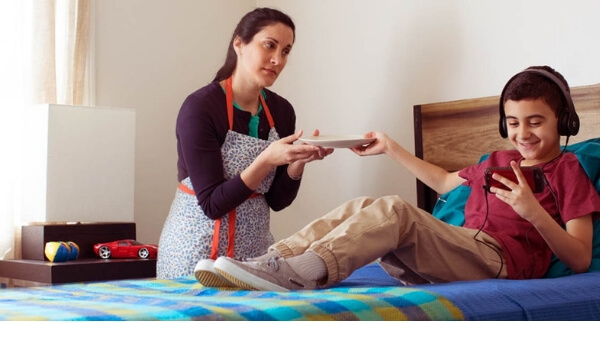Step-by-step guide to teaching table manners for kids

Introduction:
‘Table manners’ and ‘children’ go hand-in-hand. That sound of the spoon clicking on the plate, chewing loudly, talk while eating, all this is very irritating. You might have given that icy stare multiple times but it seems to be all in vain. You need to be patient here… Don’t put tons of pressure when your 5-year-old squeezes ketchup in your tea!
Learning table manners takes time. However, with the help of some efforts and tips, you can teach your innocent ones about it. Table manners are important for kids to learn and the earlier it is, the better it will be.
How do I start teaching table manners to kids:
There is no set rule for teaching table manners to your kids. But, it is advisable that you start at an early age.
To start with, you can talk about the meals you have prepared and how much fun it will be to share it with everyone at the table. Also, you can add up saying, that pleasant behavior will even make it more fun for everyone.

Table manners for kids: Age-by-age guide:
Whether you have a tiny tot who loves to make a mess and eat or a preschooler who helps you keep your weight in check, giving you a good cardio workout, or you have a little elder kid – a school going who just gobbles the food for the sake of eating and runs backs to play. There are plenty of ways to deal with different aged kids when it comes to teaching table manners. Let’s read it here:
a. Table manners for toddlers:
Toddlers love to play with whatever is there, whether it’s a toy or food. They need a constant reminder of how to behave while eating. So, it’s up to the parents to set the meal times right and show them in a playful way of how one should behave while sitting at the meal table.

You can teach them to:
• Sit at one place and eat
• Help your tiny tot to wash hands before every meal
• Teaching him to refrain from throwing food, bang spoons on the plate, screaming or spitting food
Toddlers will do things where they get attention; if dropping food is getting them the attention they will keep doing it. If politely talking is giving him full attention, well you get the idea what is working and what is not. At the very worst, you will have to repetitively do that but that’s okay.
b. Table manners for preschoolers:
“Practice makes mom perfect” should be the quote here. It’s a tough task to teach table manners to a preschooler.
Not just they are picky eaters, but they are attention seekers as well. You need to sit down with your child, apart from the meal time to explain what you are expecting at the table. Include few role play games to make the learning activity fun.
You can teach them to:
• Sit properly without wriggling, squirming or wandering around
• Patiently wait for everyone to arrive at the table
• Use the napkin and wipe the mouth after eating
• Take small bites and chew it properly
When you are taking them to a party or having a get together at your place, have them recite the table manners. Also; when they have behaved don’t forget to thank them.
c. Table manners for kids:
This age group is a bit easy to handle and also you can expect them to understand well. Parents can explain through a suitable conversation about table manners. This age group knows the difference between the “right” and “wrong”, “yes” or “no” hence table etiquettes are easy to teach.

You can teach them to:
• Use the cutlery in appropriate ways, and plate etiquettes
• Lay the table cloth / cleaning the table after the meals
• Teaching your kid to avoid saying insulting things when he/she don’t like the food
• Avoid carrying tablets or video games/gadgets to the table
Also; take their help while cleaning the kitchen after the meals. Let them understand the significance of the food, teach them how fortunate they are of getting to eat timely meals especially when they are complaining about the meal they are served.
What to do if your child misbehaves on the table?
Now that you have educated your child with proper etiquettes for eating, scolding your child for not behaving at the meal table is not going to improve them.
If your child is being unpleasant at the meal table, ask him to leave the table and don’t let him come back to finish the meal with the family. Explain that this kind of behavior is not tolerable and he can try to be good next time.
Ensure that the mealtime with the family is fun and pleasant. Talk with your kids and be encouraging about the conversation, this way he’s more likely to want to stay and share the good vibes.
4. Some basic manners that work for all age groups:
• Washing hands before every meal and coming to the table
• Placing the napkin on the lap and using it to wipe the mouth
• Not to start eating alone when at the table. Start eating when everybody has seated
• To sit upright and not to slouch
• Not to make noises while chewing food, chew with your mouth closed and not to talk until you have swallowed
• Not to make bad comments about the meals/ food
• Using ‘Please’, ‘thank you’ or words like these at the table
• Make polite conversation with everybody at the table
• Not to make noises like slurping or burping
• Ask to be excused when finished.
• Thanking a person for preparing wonderful food
• Teach them to ask whether they can help in cleaning /clearing or laying the table at your home or someone’s else.
Closing thoughts:
A child’s good manners go for a toss when your child is hungry, tired and overwhelmed during dinner. But, that shouldn’t get you off the hook from teaching your child food etiquettes.
Understand that it is okay for your little one to make mistakes. Teaching good manners to the kids might take time. But do take the time to help them learn the skills that will allow them to become more social and confident individuals in the future.




